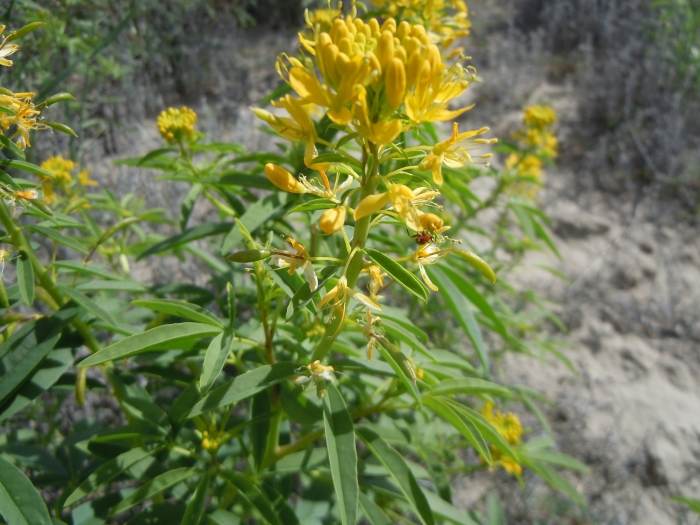Yellow Bee Plant
(Cleomella lutea)
Yellow Bee Plant (Cleomella lutea)
/
/

Matt Lavin
CC BY 4.0
Image By:
Matt Lavin
Recorded By:
Copyright:
CC BY 4.0
Copyright Notice:
Photo by: Matt Lavin | License Type: CC BY 4.0 | License URL: http://creativecommons.org/licenses/by/4.0/ | Rights Holder: Matt Lavin | Publisher: iNaturalist | Date Created: 2010-06-23T09:35:27-07:00 |
























Estimated Native Range
Summary
Cleomella lutea, commonly known as Yellow Bee Plant or Yellow Spiderflower, is an annual herb native to the arid desert washes, alkaline soils, and scrublands of the Great Basin and Mojave Desert in the western United States. It typically grows to heights exceeding 3 feet, with a sprawling growth habit. The plant features bright yellow flowers that bloom from March to June, arranged in showy inflorescences that attract pollinators such as bees. The foliage is typically bluish-green and may be covered with fine hairs.
Yellow Bee Plant is valued for its drought tolerance and ability to thrive in poor, saline soils, making it suitable for xeriscaping and habitat restoration projects. It is also used ornamentally in wildflower gardens for its vibrant flowers and as a food source for pollinators. In cultivation, it requires minimal maintenance, preferring full sun exposure and well-drained soils. While it is not commonly found in nurseries, it can be grown from seed. Some Plateau Indian tribes have traditionally used Cleomella lutea for medicinal purposes, including treating colds. However, gardeners should be aware that it can self-seed prolifically and may become weedy in favorable conditions.CC BY-SA 4.0
Yellow Bee Plant is valued for its drought tolerance and ability to thrive in poor, saline soils, making it suitable for xeriscaping and habitat restoration projects. It is also used ornamentally in wildflower gardens for its vibrant flowers and as a food source for pollinators. In cultivation, it requires minimal maintenance, preferring full sun exposure and well-drained soils. While it is not commonly found in nurseries, it can be grown from seed. Some Plateau Indian tribes have traditionally used Cleomella lutea for medicinal purposes, including treating colds. However, gardeners should be aware that it can self-seed prolifically and may become weedy in favorable conditions.CC BY-SA 4.0
Plant Description
- Plant Type: Herb
- Height: 1-2 feet
- Width: 1-3 feet
- Growth Rate: Moderate
- Flower Color: Yellow
- Flowering Season: Summer
- Leaf Retention:
Growth Requirements
- Sun: Full Sun
- Water: Low
- Drainage: Fast
Common Uses
Bee Garden, Drought Tolerant, Low Maintenance
Natural Habitat
Arid desert washes, alkaline soils, and scrublands of the Great Basin and Mojave Desert
Other Names
Common Names: Yellow Cleomella, Yellow Bee Plant
Scientific Names: , Cleomella lutea, Cleome aurea, Cleome breviflora, Cleome lutea, Cleome lutea var. lutea, Isexina aurea, Peritoma aurea, Peritoma breviflora, Peritoma lutea,
GBIF Accepted Name: